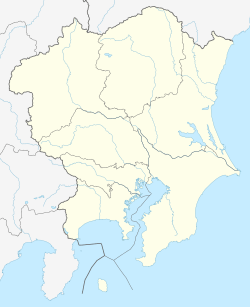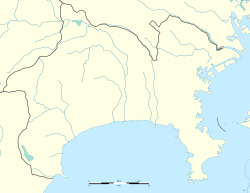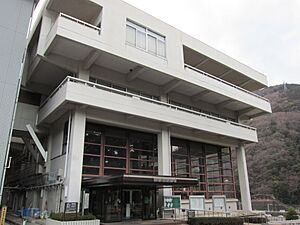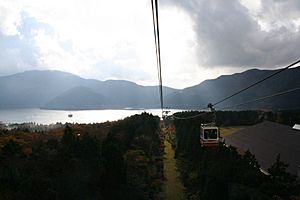Hakone facts for kids
Quick facts for kids
Hakone
箱根町
|
|||
|---|---|---|---|
|
Town
|
|||
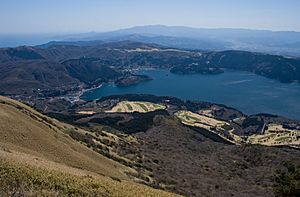
View of Lake Ashi and Hakone Town from Mount Hakone Komagatake
|
|||
|
|||
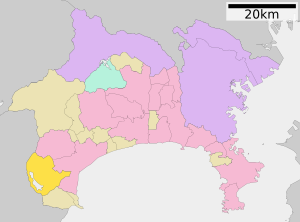
Location of Hakone in Kanagawa Prefecture (golden)
|
|||
| Country | Japan | ||
| Region | Kantō | ||
| Prefecture | Kanagawa | ||
| District | Ashigarashimo | ||
| First official recorded | 5th century BC (official) | ||
| Town settled | October 29, 1892 | ||
| Area | |||
| • Total | 92.82 km2 (35.84 sq mi) | ||
| Population
(April 1, 2021)
|
|||
| • Total | 10,837 | ||
| • Density | 116.753/km2 (302.389/sq mi) | ||
| Time zone | UTC+9 (Japan Standard Time) | ||
| - Tree | Yamazakura (Prunus jamasakura) | ||
| - Flower | Hakonebara (Rosa hirtula) | ||
| - Bird | Woodpecker | ||
| Phone number | 0460-85-7111 | ||
| Address | 256 Yumoto, Hakone-machi, Ashigarashimo-gun, Kanagawa-ken 250-0398 | ||
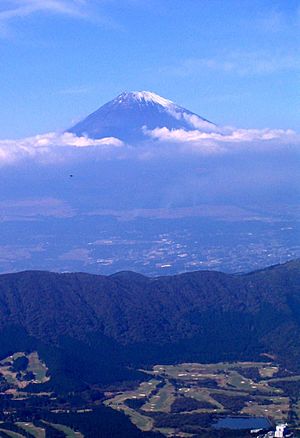
Hakone (箱根町, Hakone-machi) is a beautiful town located in Kanagawa Prefecture, Japan. It's known for its stunning natural beauty. As of 2019, about 11,293 people lived there. The town covers an area of 92.82 square kilometers. Hakone is a very popular place for tourists. People love to visit its many hot springs and enjoy amazing views of Mount Fuji.
Contents
Geography and Climate of Hakone
Hakone is nestled in the mountains in the western part of Kanagawa Prefecture. It sits on the eastern side of the Hakone Pass. Most of the town is part of the Fuji-Hakone-Izu National Park. This park is famous for its volcanoes. The beautiful Lake Ashi is right at the center of this area.
What is Hakone's Climate Like?
Hakone has a humid subtropical climate. This means it has warm summers and cool winters. There is usually light or no snowfall. The average temperature in Hakone is about 13.3°C. It gets a lot of rain, around 2221 mm per year. September is usually the wettest month. The warmest month is August, with temperatures around 24.0°C. January is the coldest, at about 2.9°C.
A Look at Hakone's History
Hakone has a long and interesting history. It is home to a famous Shinto shrine called the Hakone Gongen. This shrine is even mentioned in old Japanese stories from the Heian period.
Hakone's Role in Ancient Japan
During the Genpei War, a famous warrior named Minamoto no Yoritomo prayed at Hakone Shrine. He asked for victory after a battle. Later, during the Sengoku period, the area was controlled by the Hōjō clan.
When the Edo period began, Hakone became an important stop. It was a post station on the Tōkaidō highway. This highway connected the cities of Edo (now Tokyo) and Kyoto. Hakone also had a major checkpoint called the Hakone Checkpoint (箱根関所, Hakone sekisho). This checkpoint marked the border of the Kantō region. Officials would stop all travelers here. They checked travel permits and baggage. This was to make sure people followed laws about women and weapons.
Hakone in Modern Times
After the Meiji Restoration, Hakone became part of Kanagawa prefecture in 1876. It officially became a town in 1889. The Japanese imperial family even built a summer home near Lake Ashi. During the Meiji period, Hakone grew into a popular summer resort. Wealthy people from Tokyo and foreign visitors from Yokohama came here. In 1956, Hakone merged with five nearby towns and villages. This is how it got its current size and shape.
How Hakone is Governed
Hakone has a mayor-council form of government. This means people directly elect a mayor. There is also a town council with 14 members. These members help make decisions for the town. Hakone, along with two nearby towns, sends one person to the Kanagawa Prefectural Assembly. This assembly helps govern the larger prefecture.
Hakone's Economy and Tourism
The economy of Hakone mostly depends on tourism. Hakone is famous for its onsen hot spring resorts. These resorts attract many visitors from Japan and other countries. This is because Hakone is close to the big city of Tokyo and Mount Fuji.
Popular Attractions in Hakone
Some popular sights include the active Ōwakudani geysers. You can also visit Hakone Shrine on the shore of Lake Ashi. The Hakone Botanical Garden of Wetlands is another beautiful spot. In April, you can see amazing cherry blossoms (sakura). In autumn, the tall grass called susuki (Miscanthus sinensis) is a noted sight.
Hakone also has several art museums. These include the Hakone Open-Air Museum and Pola Museum of Art.
Events and Local Culture
Major events in Hakone include a golf tournament called the JLPGA CAT Ladies Golf. There's also the Hakone Ekiden. This is a long-distance college foot race held every New Year. It runs from Tokyo to Hakone and back over two days. It remembers the old couriers who ran along the Tōkaidō road.
The historic Fujiya Hotel in Miyanoshita is a famous hotel in Hakone. Many important writers, politicians, and foreign guests stayed there long ago. A special local craft is a type of marquetry called Yosegi. This is where different colored woods are put together to make patterns.
Hakone and Pop Culture
Hakone is also well-known among anime fans. It's the main setting for the manga and anime series Neon Genesis Evangelion. In the show, it's called Tokyo-3. You can find many attractions related to the series in the town. In 2017, Hakone was even named one of the top 88 anime pilgrimage sites.
Education in Hakone
Hakone has three public elementary schools and one public middle school. These are run by the town government. The town does not have a public high school. However, there are also private schools: two elementary schools, one middle school, and one high school. The private Seisa University also has a campus in Hakone.
Getting Around Hakone
It's easy to travel to and around Hakone. You can take the Odakyū Odawara Line from Shinjuku, Tokyo. This train takes about 70 minutes to reach Odawara. From Odawara, the Hakone Tozan Line goes into the resort towns of Hakone. The Odakyu company also runs a special express train called the Romancecar.
Local Transportation Options
Once you are in Hakone, there are many ways to explore:
- The Hakone Tozan Cable Car is a funicular train. It goes from Gōra to Sōunzan.
- The Hakone Ropeway is a cable car. It takes you to Ōwakudani from Sounzan.
- On Lake Ashi, you can ride cartoon-decorated "pirate" ships. These are for tourists to enjoy the lake.
- There is also the Hakone Komagatake Ropeway. This takes you to the top of Mount Komagatake for amazing views.
Travel Passes
A popular "Hakone Free Pass" lets you use most types of transport for several days. You can buy this pass at many train stations and bus stops in the area.
Major Roads
Several important roads pass through Hakone:
- Hakone Shindō
 National Route 1
National Route 1 National Route 138
National Route 138- Hakone Turnpike
- Ashinoko Skyline
Hakone's Sister Cities
Hakone has special friendships with other cities around the world. These are called sister cities.
- Tōyako, Hokkaidō, Japan (since 1964)
- Jasper, Alberta, Canada (since 1972)
- Taupo, New Zealand (since 1987)
- St. Moritz, Switzerland (Friendship City since 2014)
Images for kids
-
The summer festival in Hakone includes a bonfire in the shape of the kanji 大 (dai) and fireworks
See also
 In Spanish: Hakone (Kanagawa) para niños
In Spanish: Hakone (Kanagawa) para niños





